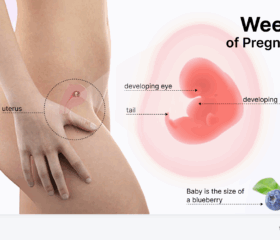What Is Pregnancy Mask (Melasma)? Causes and Treatment
One of the many body changes expecting moms may get is the "pregnancy glow.” For others, however, a less welcome surprise shows up: melasma, a skin condition that’s often called the "mask of pregnancy."

While it may look alarming, melasma is usually nothing serious. Still, let’s take a closer look at this common pregnancy symptom, learn what causes it, and go over how you can manage it during and after pregnancy.
What is melasma?
Melasma, which is also known as chloasma or pregnancy mask, is a skin condition that causes you to develop patches of hyperpigmentation. This means areas of your skin become darker than your natural complexion.
These patches are typically brown, tan, or gray. They often appear symmetrically on the face, usually on the cheeks, nose, forehead, or upper lip.
While melasma is a common pregnancy symptom, you can also get it when you’re exposed to the sun for too long or receive certain hormone therapies. Genetics can also affect whether you get melasma.
For expecting and new moms, the good news is that melasma is only a cosmetic concern. It doesn’t pose any health risks to you or your baby. It also won’t cause you any uncomfortable symptoms like itching or pain, and it isn’t contagious. 1 2
What causes melasma during pregnancy?
When you’re pregnant, your ever-changing hormones, particularly surges of your estrogen and progesterone, cause melasma.
These hormones stimulate melanocytes, the cells responsible for producing melanin, which is the pigment that gives skin its color. This overstimulation leads to your body producing too much melanin, which gives your skin the characteristic dark patches of melasma.
Several factors can also increase the chances of you getting melasma when you’re pregnant. For instance, you might be more prone to it if you have a darker skin tone, as that signifies your body produces melanin more actively than fairer-skinned people. 1 3 Other factors include your:
- Sun exposure: Again, the sun’s ultraviolet (UV) rays can cause melasma to flare up. Even a little sun exposure can make it worse. 3
- Family history: Your chances of getting melasma also statistically increase if other members of your family have had the condition. 4
- Medication: Oral contraceptives and hormone replacement therapy can both trigger melasma. 5 Of course, if you’re pregnant, you aren’t on contraceptives anymore, but if you previously had contraceptive-triggered melasma, you’re more likely to experience it during pregnancy, too.
Most women usually get melasma during the second or third trimester, when their hormone levels peak. You might also notice that your existing freckles, moles, and the linea nigra (a dark line down the center of the abdomen that often appears in pregnancy) become more prominent around this time.
How to safely manage melasma during pregnancy
While you can’t completely prevent melasma during pregnancy, you can minimize its appearance and prevent it from worsening. The key is shielding yourself from the sun’s UV rays and using a gentle skincare regimen.
Use a broad-spectrum sunscreen with an SPF of 30 or higher every day. Mineral-based sunscreens with zinc oxide, iron oxide, or titanium dioxide are your best choice, as they’re safer to use during pregnancy and provide better protection against UVA and UVB rays. 6
You should also:
- Try to limit your time in direct sunlight, especially between 10 am and 4 pm. 2
- Wear wide-brimmed hats and sunglasses that shield your face from the sun.
- Consider wearing other clothing with UV protection.
- Use gentle, fragrance-free cleansers to avoid irritating your skin.
There are studies that suggest topical Vitamin C can lighten your skin’s appearance and make melasma less prominent. 7 8 9 However, before introducing any new medications, always run them by your doctor first.
Medications your doctor might recommend
Your doctor may recommend that you try azelaic acid, one of the few topical lightening ingredients that’s considered safe for use during pregnancy. 6 10 It can help reduce your hyperpigmentation, but it may also cause mild irritation, and you’ll have to wait a few months to see any results.
Your doctor may also recommend mild glycolic acid peels to help lighten your melasma. However, you should avoid using harsh exfoliants, scrubs, and skin-lightening products containing hydroquinone, retinoids, or salicylic acid—these ingredients can potentially be harmful to your pregnancy. 11
Melasma in the postpartum period
Melasma often fades on its own after delivery or once you finish breastfeeding, when your hormone levels start returning to normal. It may take several months for it to fade (and in some cases, it may take years). 12
If melasma lingers after pregnancy, your dermatologist may prescribe stronger lightening creams containing hydroquinone or tretinoin (retinoids).
Note that using hydroquinone while breastfeeding isn’t recommended, although topical tretinoin is generally considered safe. 13 14 There hasn’t been much research into how tretinoin affects breastfeeding moms, so talk to your doctor if you’re unsure about using it. 15
Other remedies
Your dermatologist may also suggest: 6
- Chemical peels: Deeper chemical peels can help exfoliate the skin and reduce hyperpigmentation.
- Laser and light therapies: Laser treatments and intense pulsed light (IPL) therapy can target and break down melanin, but they should only be performed by a qualified professional.
- Microneedling: This is a minimally invasive procedure that makes microscopic tears in your skin. As your skin heals, your skin tone may become more even.
Outside of these dermatological treatments, you can also try a few home remedies, such as using oatmeal and honey masks, which lighten and exfoliate your skin, or diluting a little lemon juice and spreading it on your skin to lighten it. There’s limited scientific evidence for the efficacy of most of these remedies, but giving them a try won’t hurt. 16 17
Final thoughts
Don’t let the pregnancy mask alarm you. Melasma is usually harmless and should ease up not long after you give birth. If the changes to your skin bother you, there are treatments out there—just remember to check with your doctor or a dermatologist beforehand.
Otherwise, take the mask of pregnancy as a sign that your body is working hard to accommodate the life growing inside of you.
Article Sources
- American Academy of Dermatology Association. "Melasma: Overview" Retrieved May 16, 2025.
- Kaiser Permanente . "Melasma: Care Instructions" Retrieved May 16, 2025.
- Dermatology and Therapy. "Melasma: an Up-to-Date Comprehensive Review" Retrieved May 16, 2025.
- StatPearls. "Melasma" Retrieved May 16, 2025.
- Mount Sinai. "Melasma" Retrieved May 16, 2025.
- American Academy of Dermatology Association. "Melasma: Diagnosis and treatment" Retrieved May 16, 2025.
- Journal of Cosmetic Dermatology. "Efficacy of topical vitamin C in melasma and photoaging: A systematic review" Retrieved May 16, 2025.
- Journal of Cosmetic Dermatology. "A review of topical vitamin C derivatives and their efficacy" Retrieved May 16, 2025.
- Journal of Cosmetic Dermatology. "Anti-aging and brightening effects of a topical treatment containing vitamin C, vitamin E, and raspberry leaf cell culture extract: A split-face, randomized controlled trial" Retrieved May 16, 2025.
- Journal of the American Board of Family Medicine. "Treatment of Acne in Pregnancy" Retrieved May 16, 2025.
- Canadian Family Physician. "Safety of skin care products during pregnancy" Retrieved May 16, 2025.
- Dr. Len Kliman. "What Is Chloasma?" Retrieved May 16, 2025.
- MotherToBaby. "Topical Tretinoin" Retrieved May 16, 2025.
- Drugs and Lactation Database (LactMed). "Hydroquinone" Retrieved May 16, 2025.
- MotherToBaby. "Topical Tretinoin" Retrieved May 16, 2025.
- Healthline. "Are There Benefits to Using Honey and Lemon on Your Face?" Retrieved May 16, 2025.
- Medical News Today. "What are the potential benefits of oatmeal for the skin?" Retrieved May 16, 2025.







